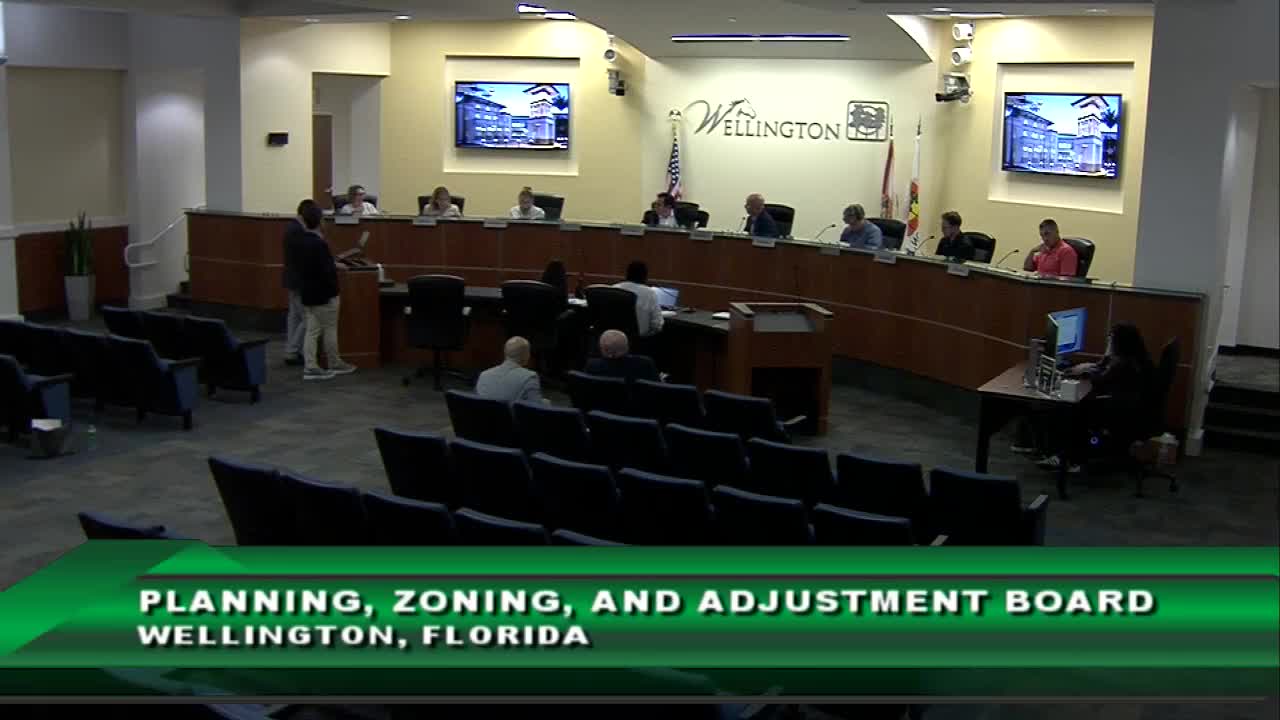Board tables bicycle parking zoning amendment, asks staff for cost and impact details
October 15, 2025 | Wellington, Palm Beach County, Florida
This article was created by AI summarizing key points discussed. AI makes mistakes, so for full details and context, please refer to the video of the full meeting. Please report any errors so we can fix them. Report an error »

The Planning, Zoning and Adjustment Board on Oct. 15 voted unanimously to table Ordinance 2025-24, a staff-initiated zoning text amendment that would revise Article 7 of the Village land development regulations to expand bicycle parking and related facilities requirements for new development and large building additions.
Why it matters: The amendment aims to improve short- and long-term bicycle parking, require a modest share of electrical outlets for e-bike charging, plan for cargo-style and adaptive bicycle spaces, and add showers and lockers for commuters in qualifying nonresidential developments. Supporters said the changes align with active-transportation goals and emerging e-bike use; board members asked for more information about costs, which developments the rules would have applied to in recent approvals, and practical considerations for enforcement.
Staff presentation and rationale
Senior planner Christian Santa Gonzalez told the board the amendment stems from a local rack-assessment study and national best-practice guidance. The proposal would apply to all new developments and to additions that increase gross floor area by 50% or more. It distinguishes type 1 (short-term) parking for visitors and customers and type 2 (long-term) parking for employees and residents, and would require certain type-2 rooms to provide electrical outlets (10% of long-term spaces) and to reserve cargo/recumbent-capable stalls when thresholds are reached. The amendment also proposes minimum shower and locker facilities for some nonresidential developments to support bicycle commuters.
Board questions and decision to table
Board members raised questions about applicability, the administrative burden and developer costs. A board member said he was concerned about “overregulation” and retrofit costs, and another asked whether existing developments would have needed the facilities if the rules had been in place earlier. Staff said the provisions would apply prospectively and offered to return with more context, including examples and cost estimates.
The board voted unanimously to table the ordinance and asked staff to return with additional analysis: estimated added construction costs for typical development types, examples of the amendment’s likely effect on recent local approvals, and clarifications about whether the showers and lockers are intended for employees only and whether type-2 electrical outlets would be in secured, interior spaces.
Ending
Staff agreed to provide additional information for a future meeting. The board did not act on the ordinance’s substance and will reconsider the amendment when staff brings supplemental cost and implementation data.
Why it matters: The amendment aims to improve short- and long-term bicycle parking, require a modest share of electrical outlets for e-bike charging, plan for cargo-style and adaptive bicycle spaces, and add showers and lockers for commuters in qualifying nonresidential developments. Supporters said the changes align with active-transportation goals and emerging e-bike use; board members asked for more information about costs, which developments the rules would have applied to in recent approvals, and practical considerations for enforcement.
Staff presentation and rationale
Senior planner Christian Santa Gonzalez told the board the amendment stems from a local rack-assessment study and national best-practice guidance. The proposal would apply to all new developments and to additions that increase gross floor area by 50% or more. It distinguishes type 1 (short-term) parking for visitors and customers and type 2 (long-term) parking for employees and residents, and would require certain type-2 rooms to provide electrical outlets (10% of long-term spaces) and to reserve cargo/recumbent-capable stalls when thresholds are reached. The amendment also proposes minimum shower and locker facilities for some nonresidential developments to support bicycle commuters.
Board questions and decision to table
Board members raised questions about applicability, the administrative burden and developer costs. A board member said he was concerned about “overregulation” and retrofit costs, and another asked whether existing developments would have needed the facilities if the rules had been in place earlier. Staff said the provisions would apply prospectively and offered to return with more context, including examples and cost estimates.
The board voted unanimously to table the ordinance and asked staff to return with additional analysis: estimated added construction costs for typical development types, examples of the amendment’s likely effect on recent local approvals, and clarifications about whether the showers and lockers are intended for employees only and whether type-2 electrical outlets would be in secured, interior spaces.
Ending
Staff agreed to provide additional information for a future meeting. The board did not act on the ordinance’s substance and will reconsider the amendment when staff brings supplemental cost and implementation data.
Don't Miss a Word: See the Full Meeting!
Go beyond summaries. Unlock every video, transcript, and key insight with a Founder Membership.
✓
Get instant access to full meeting videos
✓
Search and clip any phrase from complete transcripts
✓
Receive AI-powered summaries & custom alerts
✓
Enjoy lifetime, unrestricted access to government data
30-day money-back guarantee
